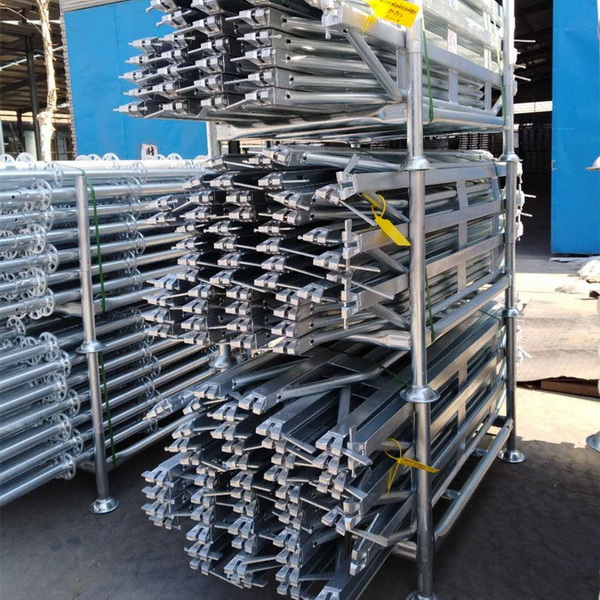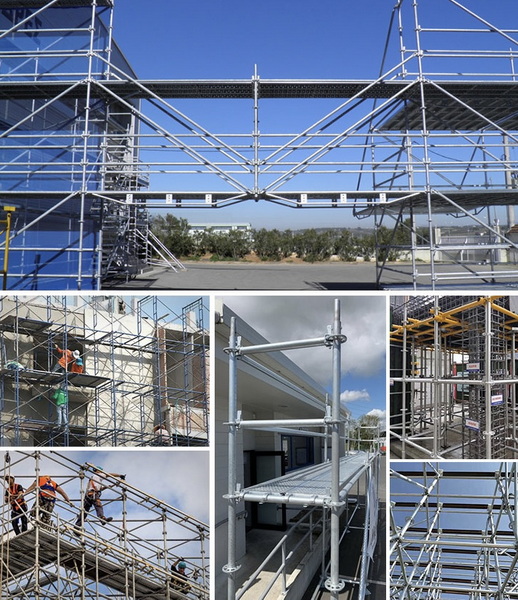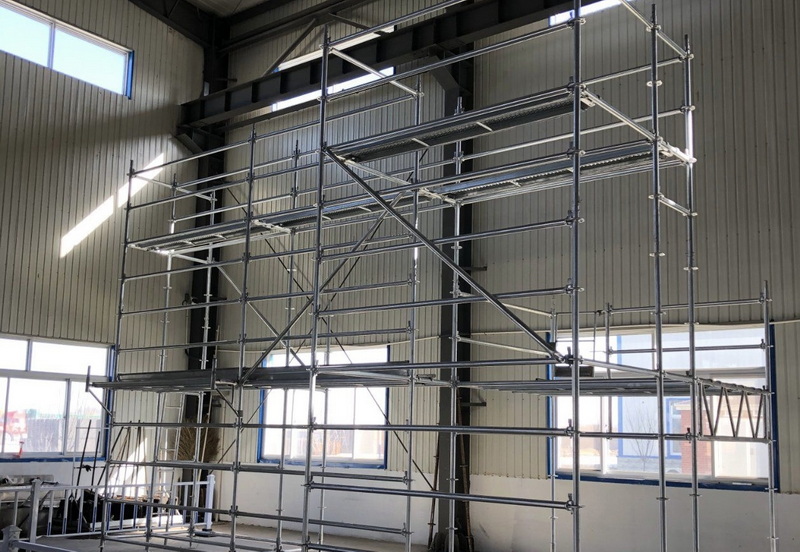Content Menu
● Components Breakdown
● How It Works
● Key Features of Ringlock Scaffolding
>> 1. Modular and Flexible Design
>> 2. High Load-Bearing Capacity
>> 3. Safety-Oriented Design
>> 4. Durability and Corrosion Resistance
>> 5. Fast Assembly and Dismantling
● Safety and Load-Bearing Capacity of Ringlock Scaffolding
>> Material Strength and Structural Stability
>> Stability on Uneven Terrain
>> Resistance to Environmental Forces
>> Compliance with Safety Standards
● Practical Applications of Ringlock Scaffolding in Heavy-Duty Projects
>> 1. High-Rise Building Construction
>> 2. Bridge and Flyover Construction
>> 3. Petrochemical and Refinery Maintenance
>> 4. Offshore Platforms and Shipyards
>> 5. Large-Scale Industrial Projects
● Advantages of Ringlock Scaffolding for Heavy-Duty Use
● Safety Tips for Using Ringlock Scaffolding in Heavy-Duty Projects
>> 1. Proper Training
>> 2. Use of Personal Protective Equipment (PPE)
>> 3. Stable and Level Foundation
>> 4. Regular Inspections
>> 5. Adherence to Load Limits
>> 6. Proper Bracing and Tying
>> 7. Weather Considerations
● Advanced Technical Insights
>> Engineering Calculations for Load Capacity
>> Finite Element Analysis (FEA)
● Environmental and Economic Benefits
>> Sustainability
>> Cost Efficiency
● Conclusion
● FAQ
>> 1. What makes ringlock scaffolding suitable for heavy-duty projects?
>> 2. Can ringlock scaffolding be used on uneven ground?
>> 3. How fast can ringlock scaffolding be assembled and dismantled?
>> 4. Does ringlock scaffolding meet safety regulations?
>> 5. What maintenance is required for ringlock scaffolding?
● Citations:
The ringlock scaffolding all-round system has become a cornerstone in modern construction and industrial sectors due to its modular design, exceptional load-bearing capacity, and comprehensive safety features. As heavy-duty projects demand scaffolding systems that can withstand rigorous conditions and provide secure working platforms, the ringlock scaffolding system stands out as a versatile and reliable solution.

Components Breakdown
- Standards: Vertical tubes with rosettes welded at regular intervals (typically every 500mm) to allow horizontal and diagonal members to connect at multiple heights.
- Ledgers: Horizontal tubes that connect between standards, providing lateral support.
- Transoms: Horizontal members placed perpendicular to ledgers to support the working platform.
- Diagonal Braces: Tubes that provide rigidity and prevent sway.
- Rosette (Ring): A circular steel plate with multiple slots welded to the standards, enabling quick connections.
- Wedges: Steel wedges hammered into place to lock the ledger or brace into the rosette slots.
How It Works
The ringlock scaffolding all-round system operates on a simple yet highly effective principle: the rosette plate acts as a hub where multiple members connect, and the wedge locks them firmly in place without bolts or screws. This design allows for rapid assembly and disassembly, while maintaining structural integrity and safety.
Key Features of Ringlock Scaffolding
1. Modular and Flexible Design
The modularity of the ringlock system allows it to be configured into various shapes and sizes, adapting to complex architectural designs and irregular surfaces. This flexibility is crucial in heavy-duty projects where scaffolding must fit around obstacles, machinery, or uneven terrain.
2. High Load-Bearing Capacity
Constructed from high-strength steel alloys such as Q235, Q345, or Q355, ringlock components can bear heavy loads safely. The rosette connection distributes forces evenly, minimizing stress concentrations and enhancing stability. This makes the system suitable for supporting heavy equipment, materials, and multiple workers simultaneously.
3. Safety-Oriented Design
Safety is paramount in scaffolding, and the ringlock system incorporates multiple features to protect workers:
- Guardrails and Toe Boards: Installed on all working platforms to prevent falls and falling objects.
- Secure Wedge Locks: Prevent accidental disassembly or loosening during use.
- Stable Platforms: Steel decks or plywood boards provide non-slip surfaces.
- Integrated Access: Aluminum staircases and ladders facilitate safe movement between levels.
4. Durability and Corrosion Resistance
Most ringlock scaffolding components undergo hot-dip galvanization, a process that coats steel with a protective zinc layer. This treatment extends the lifespan of scaffolding by preventing rust and corrosion, especially important in outdoor or marine environments.
5. Fast Assembly and Dismantling
The wedge-head locking mechanism eliminates the need for bolts or screws, allowing workers to assemble or dismantle scaffolding faster and with less effort. This efficiency reduces labor costs and project downtime.
Safety and Load-Bearing Capacity of Ringlock Scaffolding
Material Strength and Structural Stability
The ringlock scaffolding system's strength comes from both its materials and engineering design. High-grade steel tubes provide the backbone, while the rosette distributes loads across multiple connection points. This design avoids weak spots common in traditional scaffolding.
- Load Capacity: A typical ringlock scaffold tower with four standards can support vertical loads exceeding 10,000 kg (approximately 22,000 lbs) when properly braced and erected on a stable foundation.
- Rosette Strength: Each rosette connection can withstand forces of over 7,000 pounds, ensuring the scaffold remains intact even under dynamic loads such as wind or worker movement.
Stability on Uneven Terrain
Heavy-duty projects often take place on challenging sites with uneven ground or slopes. The ringlock scaffolding all-round system can be adjusted with base plates, screw jacks, or sole boards to maintain a level and stable platform. Its modular nature allows for incremental height adjustments and customized bracing to counteract instability.
Resistance to Environmental Forces
In addition to load-bearing, scaffolding must resist environmental factors like wind, rain, and seismic activity. The ringlock system's rigid frame and diagonal bracing provide excellent resistance to lateral forces, reducing sway and vibration that could compromise safety.
Compliance with Safety Standards
Ringlock scaffolding complies with international safety standards such as:
- OSHA (Occupational Safety and Health Administration) regulations in the United States.
- EN 12811 European standards for temporary works equipment.
- AS/NZS 1576 Australian/New Zealand scaffolding standards.
These standards require features such as guardrails, toe boards, secure locking systems, and maximum load limits, all of which are integral to ringlock scaffolding design.
Practical Applications of Ringlock Scaffolding in Heavy-Duty Projects
The versatility and strength of the ringlock scaffolding all-round system make it a preferred choice across various heavy-duty applications:
1. High-Rise Building Construction
In skyscraper projects, ringlock scaffolding provides safe working platforms at great heights. Its modularity allows it to be configured around complex facades and enables rapid vertical extension as the building rises.
2. Bridge and Flyover Construction
Bridges require scaffolding that can span uneven terrain and support heavy loads such as concrete forms and workers. Ringlock scaffolding's adaptability and strength make it ideal for these demanding environments.
3. Petrochemical and Refinery Maintenance
Industrial plants often have complex pipework and equipment layouts. Ringlock scaffolding can be customized to fit tight spaces and provide secure access for inspection, repair, and maintenance.
4. Offshore Platforms and Shipyards
The corrosion-resistant galvanized finish and robust design make ringlock scaffolding suitable for harsh marine environments. It supports heavy equipment and personnel safely during construction and maintenance.
5. Large-Scale Industrial Projects
Factories, power plants, and warehouses benefit from ringlock scaffolding's ability to create large, stable platforms for heavy machinery installation and maintenance.

Advantages of Ringlock Scaffolding for Heavy-Duty Use
| Feature | Benefit for Heavy-Duty Projects |
| High-strength steel | Supports heavy loads, ensuring structural safety |
| Modular design | Adapts to complex shapes and uneven terrain |
| Wedge-head locking system | Provides secure, stable connections without bolts |
| Hot-dip galvanization | Enhances durability in harsh environments |
| Integrated safety features | Continuous fall protection and stable work platforms |
| Quick assembly/disassembly | Reduces labor costs and downtime on site |
| Compliance with standards | Meets OSHA, EN, and AS/NZS safety requirements |
| Versatile applications | Suitable for industrial, commercial, and marine projects |
Safety Tips for Using Ringlock Scaffolding in Heavy-Duty Projects
To maximize safety and efficiency when using ringlock scaffolding, follow these best practices:
1. Proper Training
Ensure all personnel involved in assembly, inspection, and use are trained in ringlock scaffolding procedures, including recognizing hazards and emergency protocols.
2. Use of Personal Protective Equipment (PPE)
Workers should wear helmets, gloves, harnesses, and non-slip footwear. Harnesses should be anchored to secure points on the scaffold or building.
3. Stable and Level Foundation
Erect scaffolding on firm, level ground. Use base plates, sole boards, or screw jacks to stabilize uneven surfaces and prevent settling.
4. Regular Inspections
Inspect scaffolding daily or before each use for damaged components, loose wedges, or missing guardrails. Replace or repair defective parts immediately.
5. Adherence to Load Limits
Do not exceed the manufacturer's specified load capacities. Consider the weight of workers, tools, and materials combined.
6. Proper Bracing and Tying
Use diagonal braces and tie scaffolding to the building structure at regular intervals to prevent tipping or swaying.
7. Weather Considerations
Avoid using scaffolding during high winds, heavy rain, or icy conditions. Secure scaffolding in adverse weather to prevent accidents.
Advanced Technical Insights
Engineering Calculations for Load Capacity
The load capacity of ringlock scaffolding depends on factors such as:
- Standard tube diameter and thickness: Typically 48.3mm diameter with 3.2mm wall thickness.
- Material yield strength: Q345 steel has a yield strength of 345 MPa.
- Connection efficiency: The rosette distributes load to multiple wedges, increasing joint strength.
Structural engineers use these parameters to calculate maximum permissible loads and design scaffolding layouts that meet project requirements.
Finite Element Analysis (FEA)
Modern manufacturers employ FEA simulations to test scaffolding designs under various load conditions, including static, dynamic, and seismic forces. These simulations help optimize component dimensions and connection details for maximum safety.
Environmental and Economic Benefits
Sustainability
Hot-dip galvanized ringlock scaffolding components have a long service life, reducing the need for frequent replacements and minimizing waste. Additionally, the modular system allows components to be reused across multiple projects.
Cost Efficiency
Though initial investment may be higher than traditional scaffolding, ringlock scaffolding reduces labor costs due to faster assembly and dismantling. The durability and reusability of components also lower long-term expenses.
Conclusion
The ringlock scaffolding all-round system is a highly safe, adaptable, and efficient scaffolding solution for heavy-duty projects. Its robust construction from high-strength steel, innovative rosette and wedge locking mechanism, and comprehensive safety features make it ideal for demanding environments such as high-rise construction, industrial maintenance, and offshore platforms.
By adhering to proper assembly procedures, safety protocols, and maintenance schedules, contractors and workers can rely on ringlock scaffolding to provide secure working platforms that meet stringent safety standards. Its modularity and durability also contribute to cost savings and environmental sustainability, making it a smart choice for modern construction and industrial projects.

FAQ
1. What makes ringlock scaffolding suitable for heavy-duty projects?
Ringlock scaffolding is made from high-strength steel and features a unique rosette and wedge locking system that provides excellent load distribution and stability, allowing it to support heavy weights up to 10,000 kg or more when properly assembled.
2. Can ringlock scaffolding be used on uneven ground?
Yes, the modular design of ringlock scaffolding allows it to be adjusted and configured to fit uneven or sloped terrain, ensuring stability and safety in challenging environments.
3. How fast can ringlock scaffolding be assembled and dismantled?
Thanks to its bolt-free wedge connections, ringlock scaffolding can be erected and dismantled quickly, often with just a hammer, which reduces labor costs and downtime significantly.
4. Does ringlock scaffolding meet safety regulations?
Yes, ringlock scaffolding meets or exceeds safety standards such as those set by OSHA, including features like guardrails, toe boards, and secure locking mechanisms to protect workers from falls and accidents.
5. What maintenance is required for ringlock scaffolding?
Regular inspection for damaged components, ensuring all connections are secure, and maintaining the hot-dip galvanized finish to prevent corrosion are essential for prolonging the life and safety of ringlock scaffolding.
Citations:
[1] https://www.doka.com/au/system-groups/doka-working-scaffold-systems/working-scaffolds/ringlock/index
[2] https://www.tp-scaffold.com/can-ringlock-scaffolding-accessories-be-used-for-heavy-duty-applications.html
[3] https://www.at-pac.com/ringlock-scaffolding-system
[4] https://apacsafety.com/ringlock-standard/
[5] https://www.tp-scaffold.com/how-to-ensure-maximum-safety-with-ringlock-load-bearing-scaffolding.html
[6] https://www.youtube.com/watch?v=C7Zfpfb35yg
[7] https://www.youtube.com/watch?v=JsZkR5P7IAQ
[8] https://rapid-scafform.com/ringlock-scaffolding/
[9] https://www.youtube.com/watch?v=rUq_iPVCkXg
[10] https://www.made-in-china.com/products-search/hot-china-products/Ringlock_Scaffolding_Components.html
[11] https://www.youtube.com/watch?v=tnec3rM5kQE
[12] https://www.alibaba.com/showroom/useful-ringlock-scaffolding-system_17.html
[13] https://www.youtube.com/watch?v=LMAyZ20Ww10






















